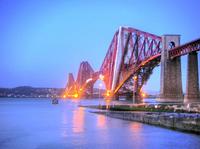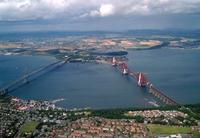You are in: Europe -> United Kingdom. Scotland -> The Forth Bridge, and traditional search or Image Gallery will yield results of this site only
The Forth Bridge
| Site number: | 1485 |
|
| Type of site: | Cultural | |
| Date: | 20-21 centuries | |
| Date of Inscription: | 2015 | |
| Location: | Europe, UK, Scotland, Ireland | |
Up to 75 images are shown here. Click on each for more details or on Image Gallery for more images.
Six official UN languages:
Chinese,
English,
French,
Russian,
Spanish
Other languages: Azerbaijani, Basque, Catalan, Croatian, Czech, Dutch, Estonian, Georgian, German, Greek, Hebrew, Hindi, Hungarian, Italian, Japanese, Korean, Luxembourgish, Norwegian-Bokmai, Norwegian-nynorsk, Polish, Portuguese, Scots, Simple English, Slovenian, Swedish, Turkish, Vietnamese
Other languages: Azerbaijani, Basque, Catalan, Croatian, Czech, Dutch, Estonian, Georgian, German, Greek, Hebrew, Hindi, Hungarian, Italian, Japanese, Korean, Luxembourgish, Norwegian-Bokmai, Norwegian-nynorsk, Polish, Portuguese, Scots, Simple English, Slovenian, Swedish, Turkish, Vietnamese
| Description: | This railway bridge spanning the estuary of the Forth River in Scotland is the world’s longest multi-span cantilever bridge. It opened in 1890 and continues to carry passengers and freight. Its distinctive industrial aesthetic is the result of a forthright and unadorned display of its structural components. Innovative in style, materials and scale, the Forth Bridge is an important milestone in bridge design and construction during the period when railways came to dominate long-distance land travel. --WHMNet's description is from WHC Site, where additional information is available. | |
| The Forth Bridge is a cantilever railway bridge over the Firth of Forth in the east of Scotland, 9 miles (14 kilometres) west of Edinburgh City Centre. It is considered an iconic structure and a symbol of Scotland, and is a UNESCO World Heritage Site. It was designed by the English engineers Sir John Fowler and Sir Benjamin Baker. Construction of the bridge began in 1882 and it was opened on 4 March 1890 by the Prince of Wales. The bridge spans the Forth between the villages of South Queensferry and North Queensferry and has a total length of 8,296 feet (2,528.7 m). It was the longest single cantilever bridge span in the world until 1917 when the Quebec Bridge in Canada was completed. It continues to be world's second-longest single cantilever span. The bridge and its associated railway infrastructure is owned by Network Rail Infrastructure Limited. --Wikipedia [http://www.wikipedia.org]. Text is available under the Creative Commons Attribution-ShareAlike License. | ||
| Source: | http://whc.unesco.org/en/list/1485 | |
| Source2: | Wikipedia (http://wikipedia.com) | |
| Reference: | 1. UNESCO World Heritage Center (http://whc.unesco.org/en/list/1485). 2. Wikipedia. | |















